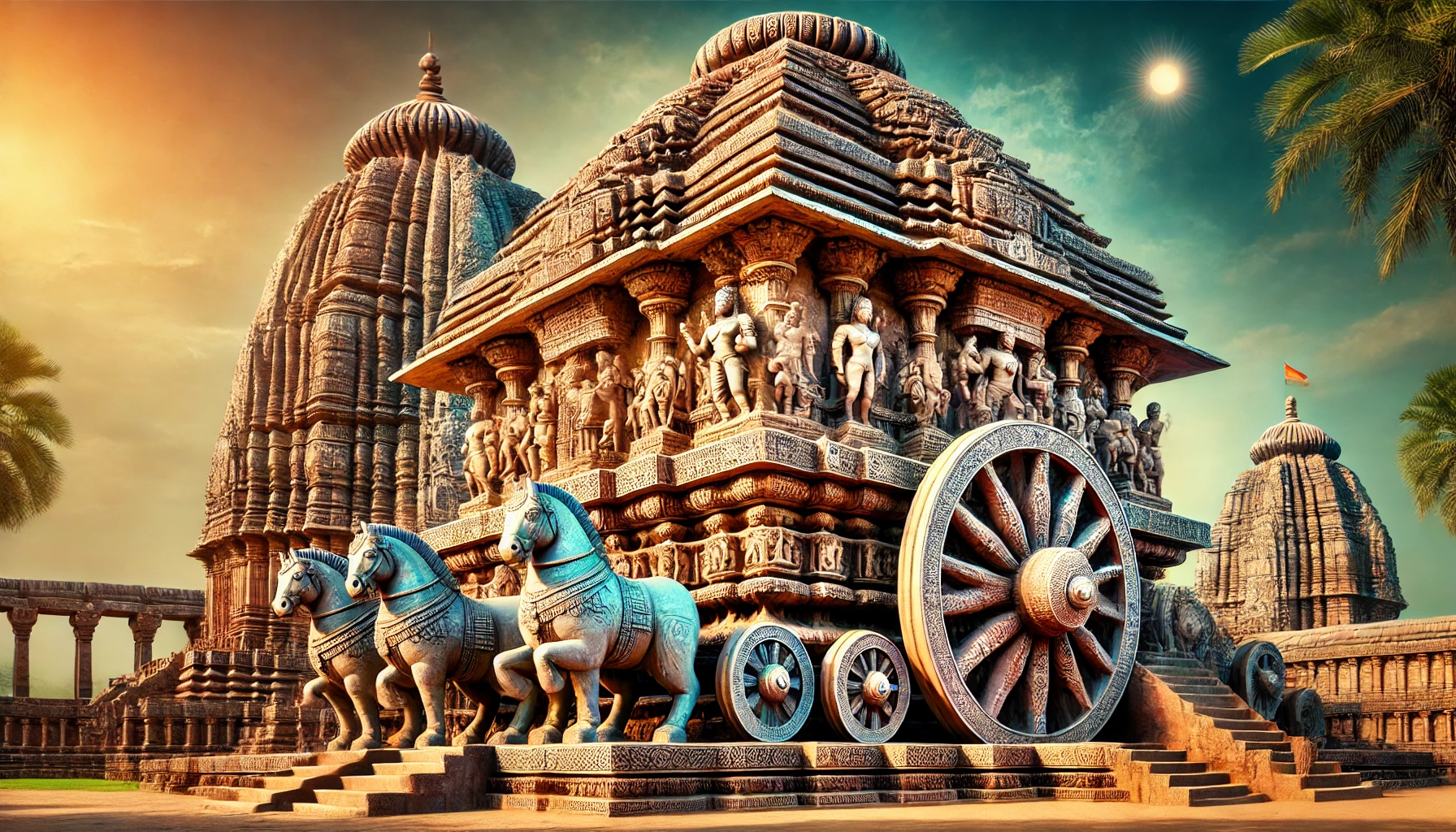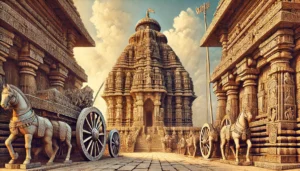
History of the Konark Sun Temple in Odisha
Sun Temple at Konark: Engineering Marvels of Ancient India
India’s ancient monuments are a testament to its rich cultural heritage and advanced knowledge of science and engineering. Among the many architectural wonders that dot the landscape, the Sun Temple at Konark in Odisha stands as an unparalleled masterpiece. Built in the 13th century CE, this grand temple is a tribute to Surya, the Sun God, and serves as a prime example of India’s architectural and engineering ingenuity. The Sun Temple is not just a place of worship but a living representation of how art, science, and spirituality converged in ancient Indian civilization.
Historical Overview: The Vision Behind the Temple
The Sun Temple at Konark was commissioned by King Narasimhadeva I of the Eastern Ganga Dynasty in 1250 CE. The king’s vision was to construct a temple that would symbolize his power, devotion to Surya, and the glory of his empire. According to historical accounts, it took 1,200 artisans and 12 years to complete this massive structure. The temple was conceived as a monumental chariot carrying the Sun God across the heavens, an architectural representation of celestial motion.
The temple’s location was carefully chosen near the coast of the Bay of Bengal, allowing the first rays of the morning sun to illuminate the deity’s idol in the sanctum sanctorum. This alignment demonstrates the advanced understanding of astronomy possessed by the architects of the time.
Table of Contents
Architectural Grandeur: A Testament to Precision
The Sun Temple is a marvel of design and execution, combining artistry with engineering techniques that were far ahead of their time. Let’s explore the key architectural highlights:
- The Celestial Chariot
The temple is designed as a colossal chariot mounted on 24 exquisitely carved wheels, each nearly 12 feet in diameter. These wheels are not just decorative but functional—they were used as sundials, enabling the calculation of time with remarkable precision. Each spoke of the wheel represents an hour, and the intricate carvings symbolize the cycle of time, emphasizing the eternal nature of life and the universe.
The chariot is pulled by seven mighty horses, representing the seven days of the week and the Sun’s seven rays. This design symbolizes the eternal journey of the Sun across the sky, a theme deeply rooted in Hindu cosmology.
- Sculptural Masterpieces
The temple’s exterior walls are adorned with over 20,000 sculptures, each more intricate and expressive than the other. These carvings depict deities, celestial beings, musicians, dancers, animals, and scenes from courtly and everyday life. The precision and detail of these sculptures reflect the exceptional craftsmanship of the artisans.
One of the unique features of the Sun Temple is its erotic sculptures, akin to those found in the Khajuraho temples. These carvings symbolize the interconnectedness of physical and spiritual life, highlighting the temple’s role as a center for both devotion and celebration of human existence.
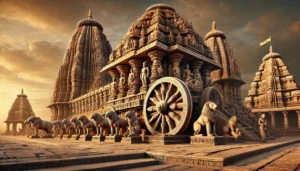
History of the Konark Sun Temple in Odisha
- Magnetic Engineering
One of the most fascinating legends surrounding the temple is its use of a lodestone, a naturally magnetized mineral, at the pinnacle of the structure. This lodestone is said to have acted as a stabilizing force, holding the massive stones together. Some accounts suggest that the magnetic force interfered with the navigation of ships passing along the coast, leading to the temple being referred to as the “Black Pagoda” by sailors.
While the lodestone no longer exists, the temple’s structural integrity, despite centuries of wear and damage, speaks volumes about the ingenuity of ancient Indian engineers.
- Interlocking Stone Construction
The temple was constructed using chlorite, laterite, and khondalite stones, joined together through advanced interlocking techniques without the use of mortar. The precision of these joints ensured that the structure remained stable even in adverse weather conditions and minor earthquakes.
- Astronomical Alignment
The temple’s alignment with the Sun’s movements is another remarkable aspect of its design. During certain times of the year, the first rays of the rising sun would pass through the main entrance and illuminate the idol of Surya in the sanctum. This interplay of light and architecture reflects the deep astronomical knowledge of the era.
Symbolism and Spiritual Significance
The Sun Temple is more than just an architectural marvel; it is a representation of profound spiritual and philosophical ideas. The seven horses symbolize the seven chakras of the human body, while the twelve wheels represent the twelve months of the year, signifying the passage of time. The Sun God, as a life-giver and sustainer of the universe, is the central theme, embodying the interconnectedness of all existence.
The temple also represents the cycle of creation and destruction, emphasizing the transient nature of human life. The intricate carvings and alignment with celestial bodies underscore the harmonious relationship between humans and the cosmos, a concept deeply rooted in Vedic philosophy.
Engineering Challenges and Decline
Despite its grandeur, the Sun Temple has not withstood the ravages of time and nature. Over the centuries, the temple suffered extensive damage due to natural calamities, including cyclones and earthquakes. Additionally, invasions by foreign rulers contributed to the desecration of the temple.
The main sanctum, or Vimana, which once housed the idol of Surya, has collapsed, leaving the Jagamohana (assembly hall) as the most intact part of the temple. Efforts by the Archaeological Survey of India (ASI) and UNESCO have been instrumental in preserving what remains of this architectural wonder.
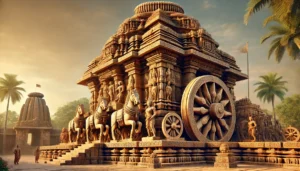
History of the Konark Sun Temple in Odisha
Restoration Efforts and Modern Recognition
Restoration of the Sun Temple has been an ongoing process, with the ASI employing modern techniques to prevent further deterioration. UNESCO recognized the temple as a World Heritage Site in 1984, bringing global attention to its historical and cultural significance. Today, the Sun Temple attracts millions of visitors annually, serving as a source of inspiration for architects, historians, and spiritual seekers.
Lessons for Modern Architecture
The Sun Temple offers valuable insights into sustainable and functional design. Its integration of art, astronomy, and engineering demonstrates how ancient Indian architects prioritized harmony with nature and cosmic rhythms. The interlocking stone technique and precision in construction are lessons in durability and resilience, principles that remain relevant for modern architectural practices.
Conclusion
The Sun Temple at Konark is a shining example of India’s glorious past, a testament to the creativity, knowledge, and devotion of its builders. Its chariot design, intricate sculptures, and advanced engineering techniques reflect a civilization that excelled in blending spirituality with science. Despite the challenges posed by time, the temple continues to inspire awe and reverence, standing as a symbol of India’s rich cultural and architectural legacy. For those who seek to unravel the mysteries of ancient India, the Sun Temple at Konark remains a beacon of timeless brilliance.
FAQs on “Konark Sun Temple: A Timeless Marvel of Ancient Indian Engineering and Art”
- What is the Konark Sun Temple?
The Konark Sun Temple is a 13th-century architectural marvel located in Konark, Odisha, India. Built by King Narasimhadeva I of the Eastern Ganga dynasty, it is dedicated to the Sun God, Surya, and designed in the shape of a colossal chariot with intricately carved wheels and horses.
- Why is the Sun Temple at Konark famous?
The Sun Temple is renowned for its intricate carvings, advanced engineering techniques, and unique chariot-like structure symbolizing the Sun God’s celestial journey. It is a UNESCO World Heritage Site and a prime example of India’s architectural brilliance.
- How is the Sun Temple an engineering marvel?
The temple’s design incorporates advanced knowledge of astronomy, geometry, and engineering. Its wheels function as sundials, and the precision of its alignment with the sunrise and sunset showcases ancient Indian expertise. The use of interlocking stones without mortar and magnetic elements in construction also highlights its innovative engineering.
- What are some unique features of the Konark Sun Temple?
The temple is shaped like a massive chariot with 24 intricately carved wheels and 7 horses.
The wheels function as timekeeping devices.
It features detailed carvings depicting mythological stories, animals, dancers, and deities.
The main sanctum once housed a giant magnetic idol of the Sun God, believed to levitate due to magnetic forces.
- Why is the Konark Sun Temple also called the “Black Pagoda”?
The temple was referred to as the “Black Pagoda” by European sailors because of its dark-colored stone and its magnetic properties, which were believed to interfere with navigation.
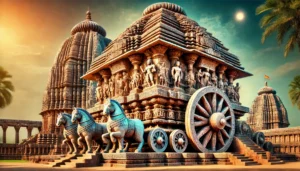
History of the Konark Sun Temple in Odisha
- What is the historical significance of the temple?
The temple reflects the cultural and religious devotion of the Eastern Ganga dynasty and showcases the peak of Odishan temple architecture. It also symbolizes the significance of the Sun God in Indian spirituality.
- Is the Konark Sun Temple still used for worship?
No, the Konark Sun Temple is no longer an active place of worship. Over the centuries, the sanctum was damaged, and the temple now serves as a historical monument and a UNESCO World Heritage Site.
- What challenges has the Konark Sun Temple faced over time?
The temple has endured natural weathering, attacks by invaders, and structural instability due to the removal of its magnetic core. Conservation efforts are ongoing to preserve its architectural and historical significance.
- What is the best time to visit the Konark Sun Temple?
The ideal time to visit is from October to February when the weather is pleasant. The Konark Dance Festival, held annually in December, is a special attraction showcasing classical Indian dance against the backdrop of the temple.
- How can I reach the Konark Sun Temple?
The temple is approximately 35 km from Puri and 65 km from Bhubaneswar. It is easily accessible by road, with regular bus and taxi services available from nearby cities. The closest airport is in Bhubaneswar.
- Are there any myths or legends associated with the temple?
Yes, one popular legend describes how the temple was constructed by Samba, Lord Krishna’s son, as an act of penance to the Sun God. Another story mentions that the magnetic idol in the sanctum caused ships to deviate from their paths, leading to its eventual removal.
- What makes the carvings on the Sun Temple unique?
The carvings depict a combination of spiritual, artistic, and everyday themes, ranging from deities and celestial beings to animals, dancers, and even depictions of human life, offering a glimpse into 13th-century Indian culture.
- Is there an entry fee for the Konark Sun Temple?
Yes, there is a nominal entry fee for visiting the temple. The charges vary for Indian and foreign tourists, with discounts available for children and students.
- Are there guided tours available for the temple?
Yes, guided tours are available, and it is recommended to hire a guide to understand the historical, architectural, and spiritual aspects of the temple in depth.
- What nearby attractions can I visit along with the Sun Temple?
Chandrabhaga Beach (3 km away)
Puri Jagannath Temple (35 km away)
Odisha State Maritime Museum (65 km away in Cuttack)
Chilika Lake, Asia’s largest brackish water lagoon
- What efforts are being made to preserve the Konark Sun Temple?
The Archaeological Survey of India (ASI) is actively involved in the conservation and restoration of the temple. Measures include structural reinforcement, cleaning of sculptures, and protection against environmental damage.
- Why should I visit the Konark Sun Temple?
Visiting the temple offers a deep appreciation of ancient Indian craftsmanship, spirituality, and architectural genius. It’s a must-see for history enthusiasts, art lovers, and travelers seeking cultural and spiritual enrichment.
Summary
The Konark Sun Temple, located on the eastern coast of Odisha, India, is a masterpiece of ancient Indian architecture and engineering, embodying the grandeur and artistic brilliance of the 13th century. Commissioned by King Narasimhadeva I of the Eastern Ganga Dynasty, this UNESCO World Heritage Site is a tribute to Surya, the Sun God, symbolizing his celestial power and omnipresence. The temple is designed as a massive chariot with twelve intricately carved wheels and seven spirited horses, representing the Sun God’s celestial journey across the sky. Each wheel is a marvel of engineering, doubling as a functional sundial that could accurately tell the time, showcasing the advanced astronomical knowledge of the time.
The temple’s architecture is a seamless blend of art and science. The placement of the temple was such that the first rays of the sun would illuminate the sanctum, highlighting its spiritual significance. It incorporates principles of symmetry, proportion, and alignment with celestial movements, reflecting the sophisticated understanding of engineering in ancient India. The intricate carvings on the walls depict scenes of daily life, mythological tales, divine figures, and celestial beings, making the temple not only a place of worship but also a repository of cultural and historical narratives.
Despite significant damage over centuries due to natural and human factors, the temple remains a symbol of resilience and creativity. The imposing structure of the main sanctum (now in ruins) and the surviving elements of the temple complex continue to captivate visitors with their scale and detail. Scholars and architects from around the world study the Konark Sun Temple for its innovative use of materials, structural ingenuity, and symbolic representation of time and space.
Beyond its architectural and artistic grandeur, the temple holds immense spiritual and cultural significance. It serves as a timeless reminder of India’s rich heritage, where devotion, science, and art were harmoniously intertwined. Today, the Konark Sun Temple stands as a source of inspiration and pride, drawing tourists, historians, and spiritual seekers to experience its awe-inspiring legacy.
Related Articles
- The Tridevi: Lakshmi, Saraswati, and Parvati – Their Roles and Powers
- “Divine Creatures of Ancient Indian Scriptures: Exploring the Role of Animals in the Vedas, Puranas, and Mahabharata”
- Nature and Spirituality: Exploring the Sacred Essence of the Himalayas, Ganga, and Other Natural Wonders”
- “Reviving the Gurukul System: Relevance and Lessons for Modern Education”
- “Exploring Greek and Indian Mythology: Similarities Between Greek and Indian Mythology “
- “Embracing Sattvic Living: Harmonizing Mind, Body, and Soul Through Food and Lifestyle”
- “Charity and Prosperity: Exploring the Concept of Daan and Its Financial Relevance in Modern Life”
- How to Build an Eco-Friendly Home Inspired by Vastu Shastra
- Comparison of Ancient and Modern Sports: How Traditional Sports Have Influenced Contemporary Games
- “Timeless Lessons from Ancient Tales: Linking Samudra Manthan and Ganga’s Descent to Modern Ecological Challenges”
- “Reviving Sanskrit: How AI is Preserving Ancient Languages for the Future”
- “Mathura: The Sacred Land of Lord Krishna’s Divine Leelas”
- Investing for Future Generations: Lessons from Indian Traditions on Legacy Building and Wealth Preservation
- “Ancient Indian Wisdom: Timeless Lessons for Tackling Today’s Climate Crisis”
- “Artificial Intelligence and Spirituality: Transforming Ancient Practices for the Modern World”
- “Gold and Real Estate in India: Timeless Assets Shaping Financial Strategies”
- “Divine Feminine Power in Hindu Mythology: The Legends of Durga, Saraswati, and Lakshmi”
- “Divine Beings of Sanatan Dharma: The Spiritual Significance of Sacred Animals in Hinduism”
- “Symbolism in Mythological Art: Unlocking Hidden Meanings in Ancient Temple Carvings”
- “Exploring Technological Advancements in Ancient India and Civilizations: Vimana, Metallurgy, & Water Management systems”
- Unveiling the Mysteries: Ancient Temples of Sanatan Dharma , Mysterious Temples of India
- “The Scientific Knowledge of Sanatan Dharma: Ancient Wisdom Meets Modern Science”
- Ancient Indian Sports and Games: Celebrating a Legacy of Skill, Strength & Strategy”
- “Exploring the Cosmic Link: The Connection Between Astronomy and Vedic Astrology”
- The Power of Sanskrit: Unlocking the Divine Language of the Gods
- “The End of Kaliyuga: A Sanatan Insight into the World’s Final Chapter”
- Explore more articles on Prachin Sanatan Yuga.
History of the Konark Sun Temple in Odisha History of the Konark Sun Temple in Odisha History of the Konark Sun Temple in Odisha History of the Konark Sun Temple in Odisha History of the Konark Sun Temple in Odisha History of the Konark Sun Temple in Odisha History of the Konark Sun Temple in Odisha History of the Konark Sun Temple in Odisha
History of the Konark Sun Temple in Odisha History of the Konark Sun Temple in Odisha History of the Konark Sun Temple in Odisha History of the Konark Sun Temple in Odisha History of the Konark Sun Temple in Odisha History of the Konark Sun Temple in Odisha History of the Konark Sun Temple in Odisha History of the Konark Sun Temple in Odisha History of the Konark Sun Temple in Odisha
History of the Konark Sun Temple in Odisha History of the Konark Sun Temple in Odisha History of the Konark Sun Temple in Odisha History of the Konark Sun Temple in Odisha History of the Konark Sun Temple in Odisha History of the Konark Sun Temple in Odisha History of the Konark Sun Temple in Odisha History of the Konark Sun Temple in Odisha
konark temple konark temple konark temple konark temple konark temple konark temple
konark temple konark temple konark temple konark temple konark temple konark temple
